Tuberculosis in India: Report
VerifiedAdded on 2023/01/20
|14
|3814
|60
AI Summary
This report provides detailed knowledge about the outbreak of tuberculosis in India, including its epidemiology, factors contributing to the outbreak, and its status as a public health issue. It highlights the impact of socioeconomic status and poverty on the prevalence of tuberculosis in the Indian population.
Contribute Materials
Your contribution can guide someone’s learning journey. Share your
documents today.
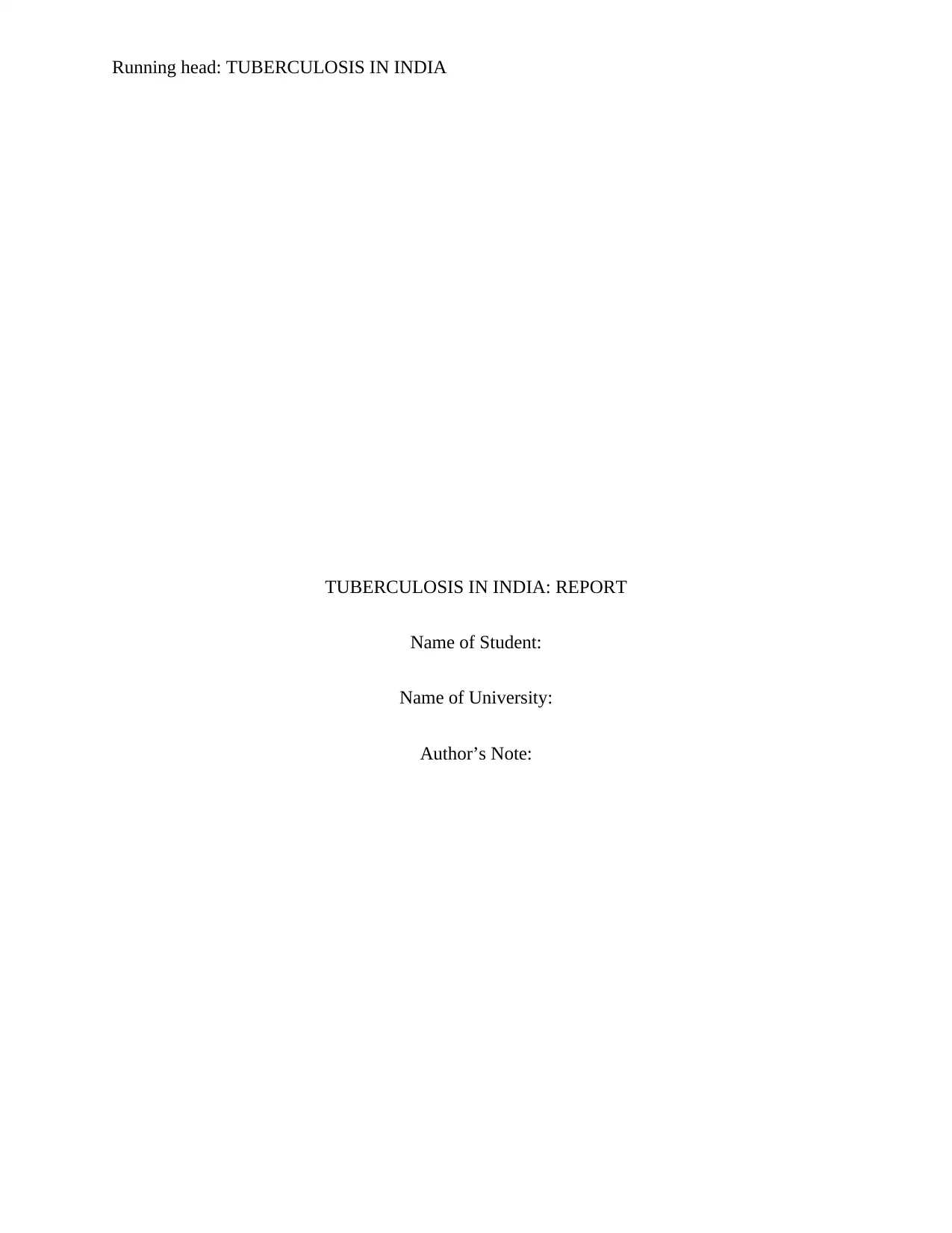
Running head: TUBERCULOSIS IN INDIA
TUBERCULOSIS IN INDIA: REPORT
Name of Student:
Name of University:
Author’s Note:
TUBERCULOSIS IN INDIA: REPORT
Name of Student:
Name of University:
Author’s Note:
Secure Best Marks with AI Grader
Need help grading? Try our AI Grader for instant feedback on your assignments.
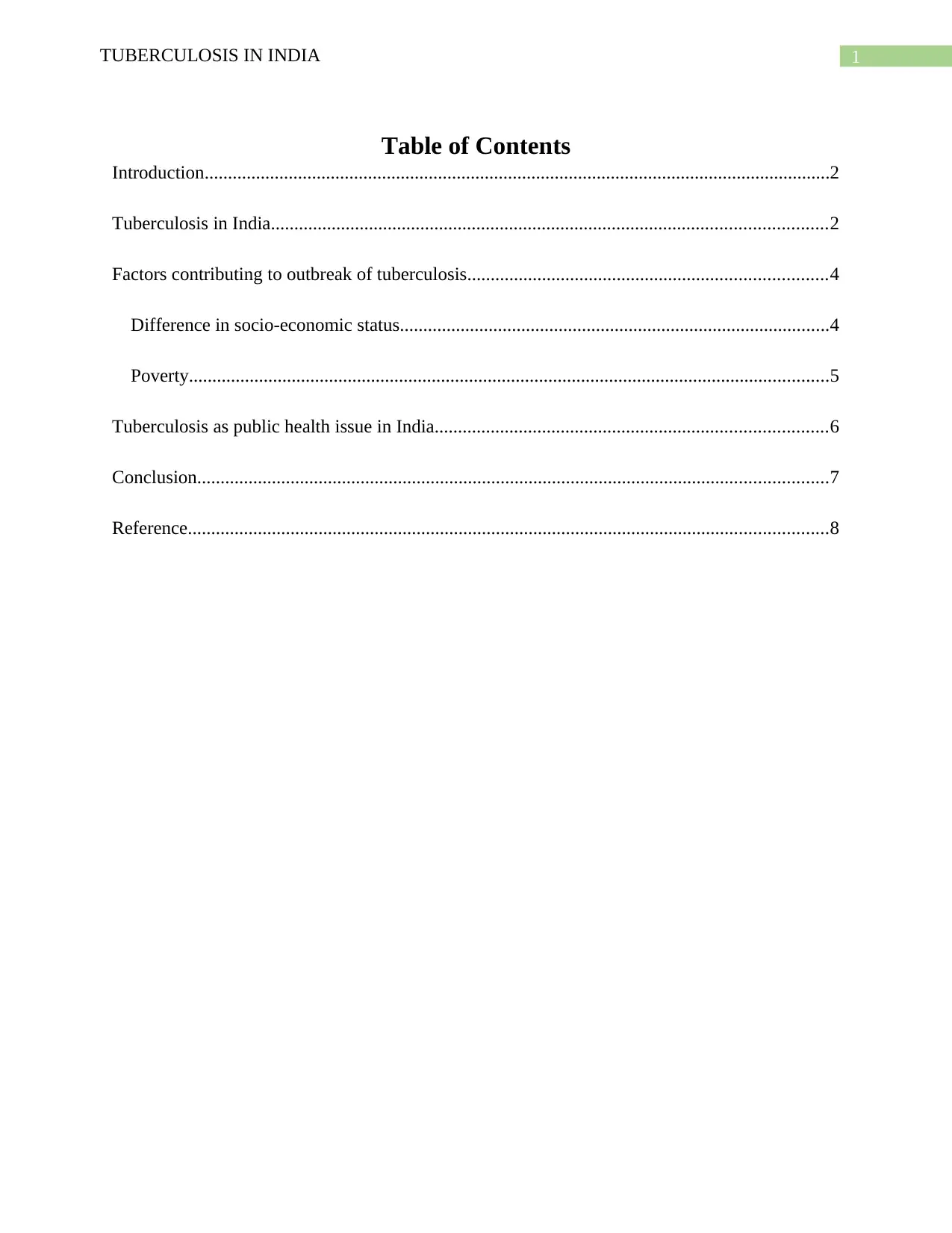
1TUBERCULOSIS IN INDIA
Table of Contents
Introduction......................................................................................................................................2
Tuberculosis in India.......................................................................................................................2
Factors contributing to outbreak of tuberculosis.............................................................................4
Difference in socio-economic status............................................................................................4
Poverty.........................................................................................................................................5
Tuberculosis as public health issue in India....................................................................................6
Conclusion.......................................................................................................................................7
Reference.........................................................................................................................................8
Table of Contents
Introduction......................................................................................................................................2
Tuberculosis in India.......................................................................................................................2
Factors contributing to outbreak of tuberculosis.............................................................................4
Difference in socio-economic status............................................................................................4
Poverty.........................................................................................................................................5
Tuberculosis as public health issue in India....................................................................................6
Conclusion.......................................................................................................................................7
Reference.........................................................................................................................................8
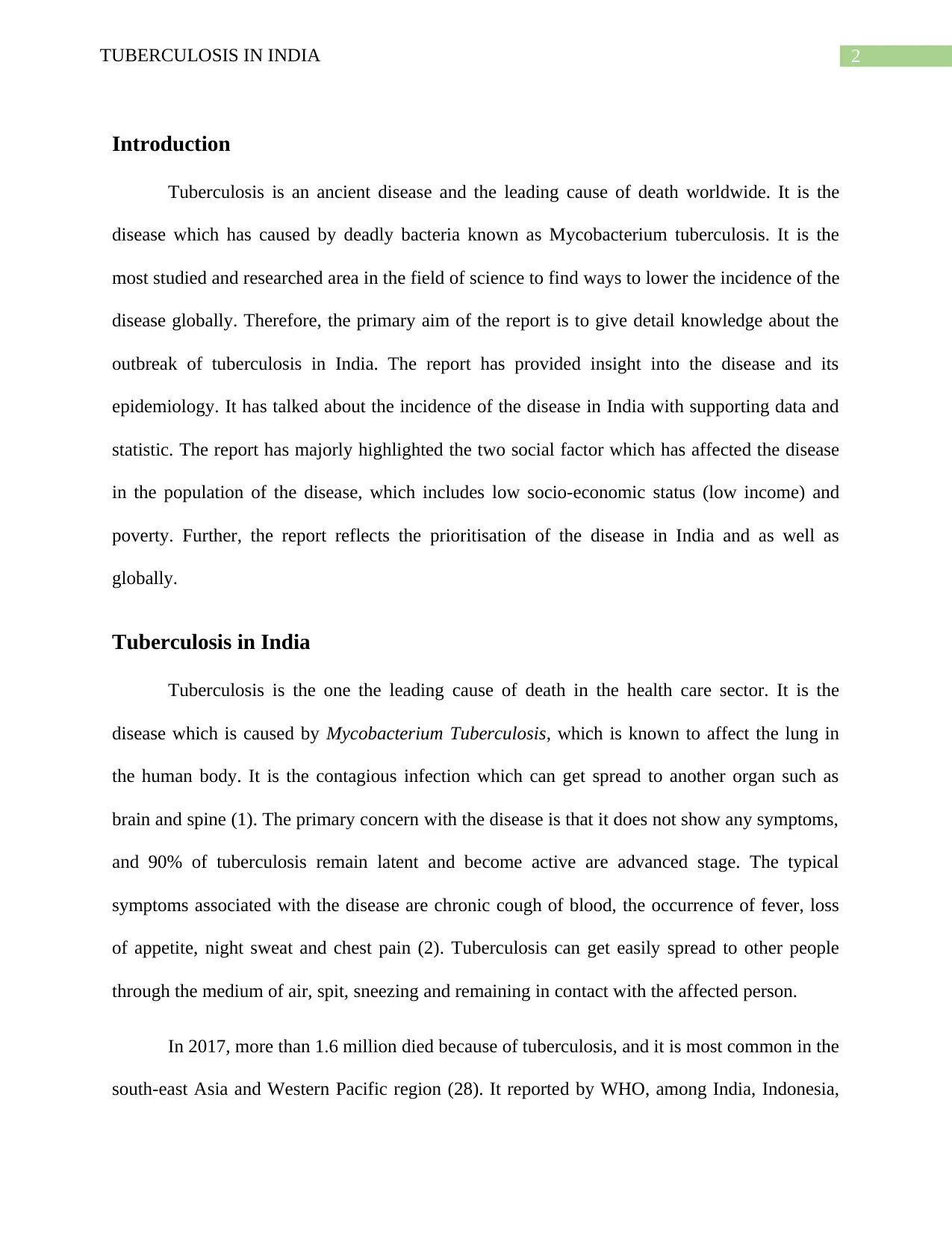
2TUBERCULOSIS IN INDIA
Introduction
Tuberculosis is an ancient disease and the leading cause of death worldwide. It is the
disease which has caused by deadly bacteria known as Mycobacterium tuberculosis. It is the
most studied and researched area in the field of science to find ways to lower the incidence of the
disease globally. Therefore, the primary aim of the report is to give detail knowledge about the
outbreak of tuberculosis in India. The report has provided insight into the disease and its
epidemiology. It has talked about the incidence of the disease in India with supporting data and
statistic. The report has majorly highlighted the two social factor which has affected the disease
in the population of the disease, which includes low socio-economic status (low income) and
poverty. Further, the report reflects the prioritisation of the disease in India and as well as
globally.
Tuberculosis in India
Tuberculosis is the one the leading cause of death in the health care sector. It is the
disease which is caused by Mycobacterium Tuberculosis, which is known to affect the lung in
the human body. It is the contagious infection which can get spread to another organ such as
brain and spine (1). The primary concern with the disease is that it does not show any symptoms,
and 90% of tuberculosis remain latent and become active are advanced stage. The typical
symptoms associated with the disease are chronic cough of blood, the occurrence of fever, loss
of appetite, night sweat and chest pain (2). Tuberculosis can get easily spread to other people
through the medium of air, spit, sneezing and remaining in contact with the affected person.
In 2017, more than 1.6 million died because of tuberculosis, and it is most common in the
south-east Asia and Western Pacific region (28). It reported by WHO, among India, Indonesia,
Introduction
Tuberculosis is an ancient disease and the leading cause of death worldwide. It is the
disease which has caused by deadly bacteria known as Mycobacterium tuberculosis. It is the
most studied and researched area in the field of science to find ways to lower the incidence of the
disease globally. Therefore, the primary aim of the report is to give detail knowledge about the
outbreak of tuberculosis in India. The report has provided insight into the disease and its
epidemiology. It has talked about the incidence of the disease in India with supporting data and
statistic. The report has majorly highlighted the two social factor which has affected the disease
in the population of the disease, which includes low socio-economic status (low income) and
poverty. Further, the report reflects the prioritisation of the disease in India and as well as
globally.
Tuberculosis in India
Tuberculosis is the one the leading cause of death in the health care sector. It is the
disease which is caused by Mycobacterium Tuberculosis, which is known to affect the lung in
the human body. It is the contagious infection which can get spread to another organ such as
brain and spine (1). The primary concern with the disease is that it does not show any symptoms,
and 90% of tuberculosis remain latent and become active are advanced stage. The typical
symptoms associated with the disease are chronic cough of blood, the occurrence of fever, loss
of appetite, night sweat and chest pain (2). Tuberculosis can get easily spread to other people
through the medium of air, spit, sneezing and remaining in contact with the affected person.
In 2017, more than 1.6 million died because of tuberculosis, and it is most common in the
south-east Asia and Western Pacific region (28). It reported by WHO, among India, Indonesia,
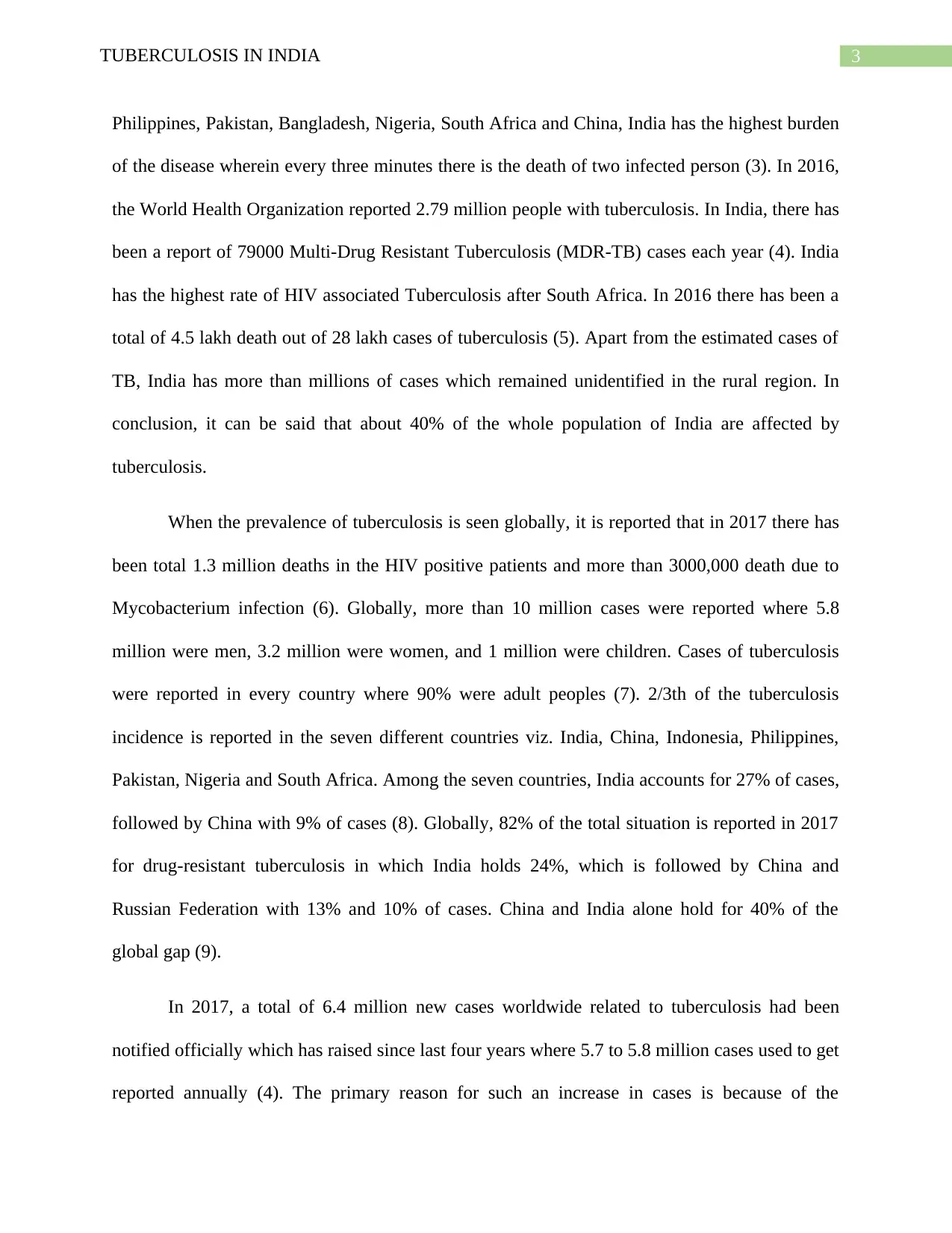
3TUBERCULOSIS IN INDIA
Philippines, Pakistan, Bangladesh, Nigeria, South Africa and China, India has the highest burden
of the disease wherein every three minutes there is the death of two infected person (3). In 2016,
the World Health Organization reported 2.79 million people with tuberculosis. In India, there has
been a report of 79000 Multi-Drug Resistant Tuberculosis (MDR-TB) cases each year (4). India
has the highest rate of HIV associated Tuberculosis after South Africa. In 2016 there has been a
total of 4.5 lakh death out of 28 lakh cases of tuberculosis (5). Apart from the estimated cases of
TB, India has more than millions of cases which remained unidentified in the rural region. In
conclusion, it can be said that about 40% of the whole population of India are affected by
tuberculosis.
When the prevalence of tuberculosis is seen globally, it is reported that in 2017 there has
been total 1.3 million deaths in the HIV positive patients and more than 3000,000 death due to
Mycobacterium infection (6). Globally, more than 10 million cases were reported where 5.8
million were men, 3.2 million were women, and 1 million were children. Cases of tuberculosis
were reported in every country where 90% were adult peoples (7). 2/3th of the tuberculosis
incidence is reported in the seven different countries viz. India, China, Indonesia, Philippines,
Pakistan, Nigeria and South Africa. Among the seven countries, India accounts for 27% of cases,
followed by China with 9% of cases (8). Globally, 82% of the total situation is reported in 2017
for drug-resistant tuberculosis in which India holds 24%, which is followed by China and
Russian Federation with 13% and 10% of cases. China and India alone hold for 40% of the
global gap (9).
In 2017, a total of 6.4 million new cases worldwide related to tuberculosis had been
notified officially which has raised since last four years where 5.7 to 5.8 million cases used to get
reported annually (4). The primary reason for such an increase in cases is because of the
Philippines, Pakistan, Bangladesh, Nigeria, South Africa and China, India has the highest burden
of the disease wherein every three minutes there is the death of two infected person (3). In 2016,
the World Health Organization reported 2.79 million people with tuberculosis. In India, there has
been a report of 79000 Multi-Drug Resistant Tuberculosis (MDR-TB) cases each year (4). India
has the highest rate of HIV associated Tuberculosis after South Africa. In 2016 there has been a
total of 4.5 lakh death out of 28 lakh cases of tuberculosis (5). Apart from the estimated cases of
TB, India has more than millions of cases which remained unidentified in the rural region. In
conclusion, it can be said that about 40% of the whole population of India are affected by
tuberculosis.
When the prevalence of tuberculosis is seen globally, it is reported that in 2017 there has
been total 1.3 million deaths in the HIV positive patients and more than 3000,000 death due to
Mycobacterium infection (6). Globally, more than 10 million cases were reported where 5.8
million were men, 3.2 million were women, and 1 million were children. Cases of tuberculosis
were reported in every country where 90% were adult peoples (7). 2/3th of the tuberculosis
incidence is reported in the seven different countries viz. India, China, Indonesia, Philippines,
Pakistan, Nigeria and South Africa. Among the seven countries, India accounts for 27% of cases,
followed by China with 9% of cases (8). Globally, 82% of the total situation is reported in 2017
for drug-resistant tuberculosis in which India holds 24%, which is followed by China and
Russian Federation with 13% and 10% of cases. China and India alone hold for 40% of the
global gap (9).
In 2017, a total of 6.4 million new cases worldwide related to tuberculosis had been
notified officially which has raised since last four years where 5.7 to 5.8 million cases used to get
reported annually (4). The primary reason for such an increase in cases is because of the
Secure Best Marks with AI Grader
Need help grading? Try our AI Grader for instant feedback on your assignments.
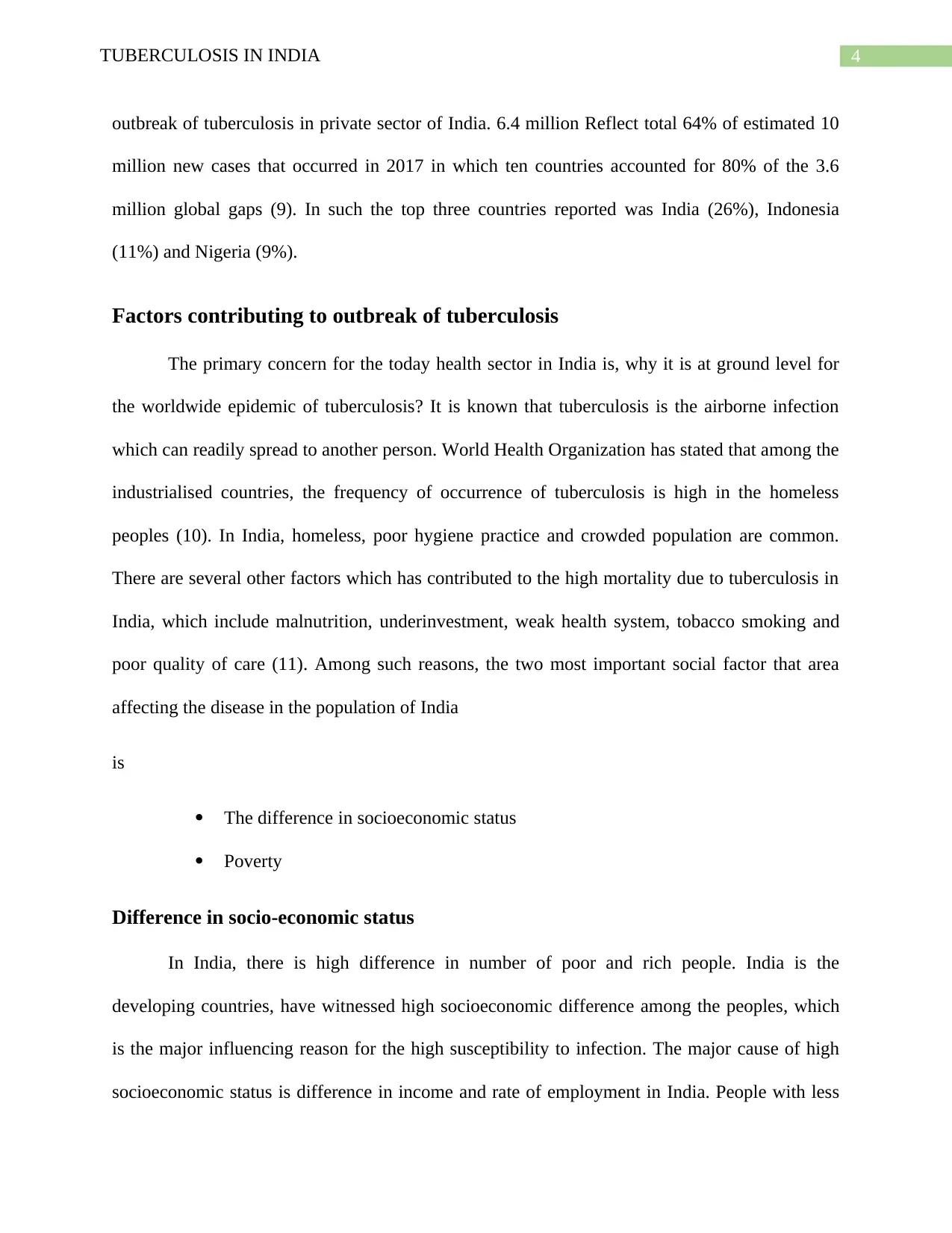
4TUBERCULOSIS IN INDIA
outbreak of tuberculosis in private sector of India. 6.4 million Reflect total 64% of estimated 10
million new cases that occurred in 2017 in which ten countries accounted for 80% of the 3.6
million global gaps (9). In such the top three countries reported was India (26%), Indonesia
(11%) and Nigeria (9%).
Factors contributing to outbreak of tuberculosis
The primary concern for the today health sector in India is, why it is at ground level for
the worldwide epidemic of tuberculosis? It is known that tuberculosis is the airborne infection
which can readily spread to another person. World Health Organization has stated that among the
industrialised countries, the frequency of occurrence of tuberculosis is high in the homeless
peoples (10). In India, homeless, poor hygiene practice and crowded population are common.
There are several other factors which has contributed to the high mortality due to tuberculosis in
India, which include malnutrition, underinvestment, weak health system, tobacco smoking and
poor quality of care (11). Among such reasons, the two most important social factor that area
affecting the disease in the population of India
is
The difference in socioeconomic status
Poverty
Difference in socio-economic status
In India, there is high difference in number of poor and rich people. India is the
developing countries, have witnessed high socioeconomic difference among the peoples, which
is the major influencing reason for the high susceptibility to infection. The major cause of high
socioeconomic status is difference in income and rate of employment in India. People with less
outbreak of tuberculosis in private sector of India. 6.4 million Reflect total 64% of estimated 10
million new cases that occurred in 2017 in which ten countries accounted for 80% of the 3.6
million global gaps (9). In such the top three countries reported was India (26%), Indonesia
(11%) and Nigeria (9%).
Factors contributing to outbreak of tuberculosis
The primary concern for the today health sector in India is, why it is at ground level for
the worldwide epidemic of tuberculosis? It is known that tuberculosis is the airborne infection
which can readily spread to another person. World Health Organization has stated that among the
industrialised countries, the frequency of occurrence of tuberculosis is high in the homeless
peoples (10). In India, homeless, poor hygiene practice and crowded population are common.
There are several other factors which has contributed to the high mortality due to tuberculosis in
India, which include malnutrition, underinvestment, weak health system, tobacco smoking and
poor quality of care (11). Among such reasons, the two most important social factor that area
affecting the disease in the population of India
is
The difference in socioeconomic status
Poverty
Difference in socio-economic status
In India, there is high difference in number of poor and rich people. India is the
developing countries, have witnessed high socioeconomic difference among the peoples, which
is the major influencing reason for the high susceptibility to infection. The major cause of high
socioeconomic status is difference in income and rate of employment in India. People with less
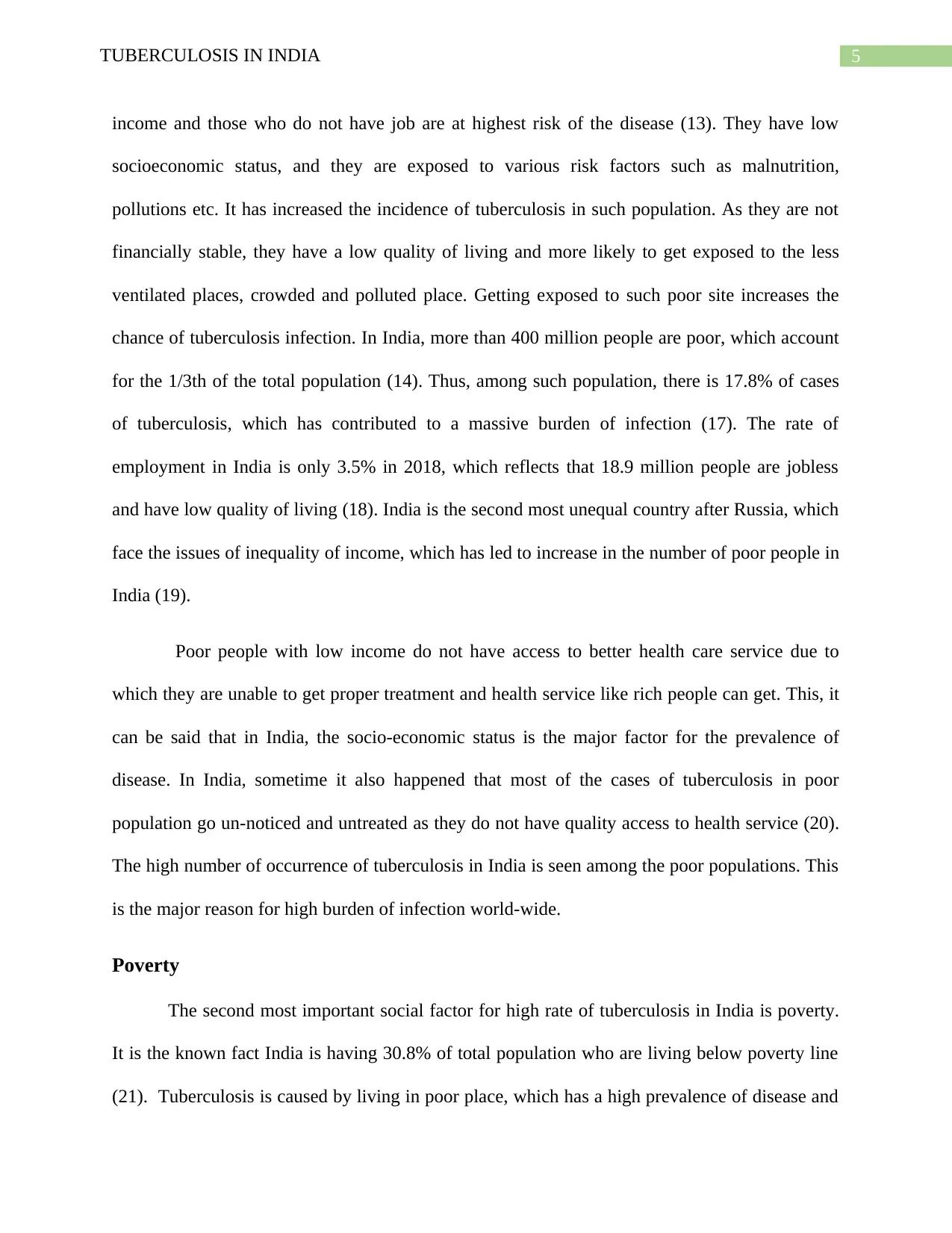
5TUBERCULOSIS IN INDIA
income and those who do not have job are at highest risk of the disease (13). They have low
socioeconomic status, and they are exposed to various risk factors such as malnutrition,
pollutions etc. It has increased the incidence of tuberculosis in such population. As they are not
financially stable, they have a low quality of living and more likely to get exposed to the less
ventilated places, crowded and polluted place. Getting exposed to such poor site increases the
chance of tuberculosis infection. In India, more than 400 million people are poor, which account
for the 1/3th of the total population (14). Thus, among such population, there is 17.8% of cases
of tuberculosis, which has contributed to a massive burden of infection (17). The rate of
employment in India is only 3.5% in 2018, which reflects that 18.9 million people are jobless
and have low quality of living (18). India is the second most unequal country after Russia, which
face the issues of inequality of income, which has led to increase in the number of poor people in
India (19).
Poor people with low income do not have access to better health care service due to
which they are unable to get proper treatment and health service like rich people can get. This, it
can be said that in India, the socio-economic status is the major factor for the prevalence of
disease. In India, sometime it also happened that most of the cases of tuberculosis in poor
population go un-noticed and untreated as they do not have quality access to health service (20).
The high number of occurrence of tuberculosis in India is seen among the poor populations. This
is the major reason for high burden of infection world-wide.
Poverty
The second most important social factor for high rate of tuberculosis in India is poverty.
It is the known fact India is having 30.8% of total population who are living below poverty line
(21). Tuberculosis is caused by living in poor place, which has a high prevalence of disease and
income and those who do not have job are at highest risk of the disease (13). They have low
socioeconomic status, and they are exposed to various risk factors such as malnutrition,
pollutions etc. It has increased the incidence of tuberculosis in such population. As they are not
financially stable, they have a low quality of living and more likely to get exposed to the less
ventilated places, crowded and polluted place. Getting exposed to such poor site increases the
chance of tuberculosis infection. In India, more than 400 million people are poor, which account
for the 1/3th of the total population (14). Thus, among such population, there is 17.8% of cases
of tuberculosis, which has contributed to a massive burden of infection (17). The rate of
employment in India is only 3.5% in 2018, which reflects that 18.9 million people are jobless
and have low quality of living (18). India is the second most unequal country after Russia, which
face the issues of inequality of income, which has led to increase in the number of poor people in
India (19).
Poor people with low income do not have access to better health care service due to
which they are unable to get proper treatment and health service like rich people can get. This, it
can be said that in India, the socio-economic status is the major factor for the prevalence of
disease. In India, sometime it also happened that most of the cases of tuberculosis in poor
population go un-noticed and untreated as they do not have quality access to health service (20).
The high number of occurrence of tuberculosis in India is seen among the poor populations. This
is the major reason for high burden of infection world-wide.
Poverty
The second most important social factor for high rate of tuberculosis in India is poverty.
It is the known fact India is having 30.8% of total population who are living below poverty line
(21). Tuberculosis is caused by living in poor place, which has a high prevalence of disease and
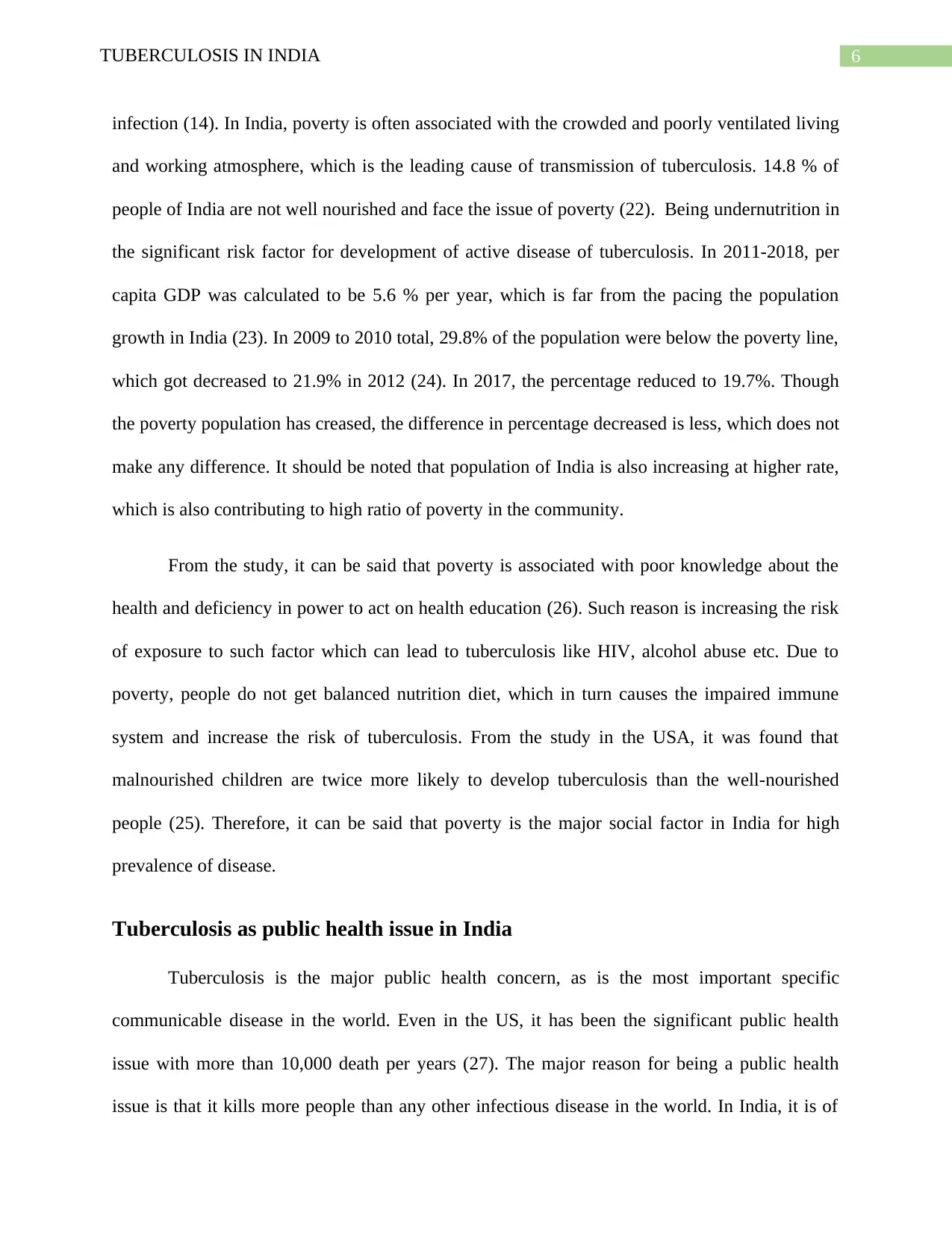
6TUBERCULOSIS IN INDIA
infection (14). In India, poverty is often associated with the crowded and poorly ventilated living
and working atmosphere, which is the leading cause of transmission of tuberculosis. 14.8 % of
people of India are not well nourished and face the issue of poverty (22). Being undernutrition in
the significant risk factor for development of active disease of tuberculosis. In 2011-2018, per
capita GDP was calculated to be 5.6 % per year, which is far from the pacing the population
growth in India (23). In 2009 to 2010 total, 29.8% of the population were below the poverty line,
which got decreased to 21.9% in 2012 (24). In 2017, the percentage reduced to 19.7%. Though
the poverty population has creased, the difference in percentage decreased is less, which does not
make any difference. It should be noted that population of India is also increasing at higher rate,
which is also contributing to high ratio of poverty in the community.
From the study, it can be said that poverty is associated with poor knowledge about the
health and deficiency in power to act on health education (26). Such reason is increasing the risk
of exposure to such factor which can lead to tuberculosis like HIV, alcohol abuse etc. Due to
poverty, people do not get balanced nutrition diet, which in turn causes the impaired immune
system and increase the risk of tuberculosis. From the study in the USA, it was found that
malnourished children are twice more likely to develop tuberculosis than the well-nourished
people (25). Therefore, it can be said that poverty is the major social factor in India for high
prevalence of disease.
Tuberculosis as public health issue in India
Tuberculosis is the major public health concern, as is the most important specific
communicable disease in the world. Even in the US, it has been the significant public health
issue with more than 10,000 death per years (27). The major reason for being a public health
issue is that it kills more people than any other infectious disease in the world. In India, it is of
infection (14). In India, poverty is often associated with the crowded and poorly ventilated living
and working atmosphere, which is the leading cause of transmission of tuberculosis. 14.8 % of
people of India are not well nourished and face the issue of poverty (22). Being undernutrition in
the significant risk factor for development of active disease of tuberculosis. In 2011-2018, per
capita GDP was calculated to be 5.6 % per year, which is far from the pacing the population
growth in India (23). In 2009 to 2010 total, 29.8% of the population were below the poverty line,
which got decreased to 21.9% in 2012 (24). In 2017, the percentage reduced to 19.7%. Though
the poverty population has creased, the difference in percentage decreased is less, which does not
make any difference. It should be noted that population of India is also increasing at higher rate,
which is also contributing to high ratio of poverty in the community.
From the study, it can be said that poverty is associated with poor knowledge about the
health and deficiency in power to act on health education (26). Such reason is increasing the risk
of exposure to such factor which can lead to tuberculosis like HIV, alcohol abuse etc. Due to
poverty, people do not get balanced nutrition diet, which in turn causes the impaired immune
system and increase the risk of tuberculosis. From the study in the USA, it was found that
malnourished children are twice more likely to develop tuberculosis than the well-nourished
people (25). Therefore, it can be said that poverty is the major social factor in India for high
prevalence of disease.
Tuberculosis as public health issue in India
Tuberculosis is the major public health concern, as is the most important specific
communicable disease in the world. Even in the US, it has been the significant public health
issue with more than 10,000 death per years (27). The major reason for being a public health
issue is that it kills more people than any other infectious disease in the world. In India, it is of
Paraphrase This Document
Need a fresh take? Get an instant paraphrase of this document with our AI Paraphraser
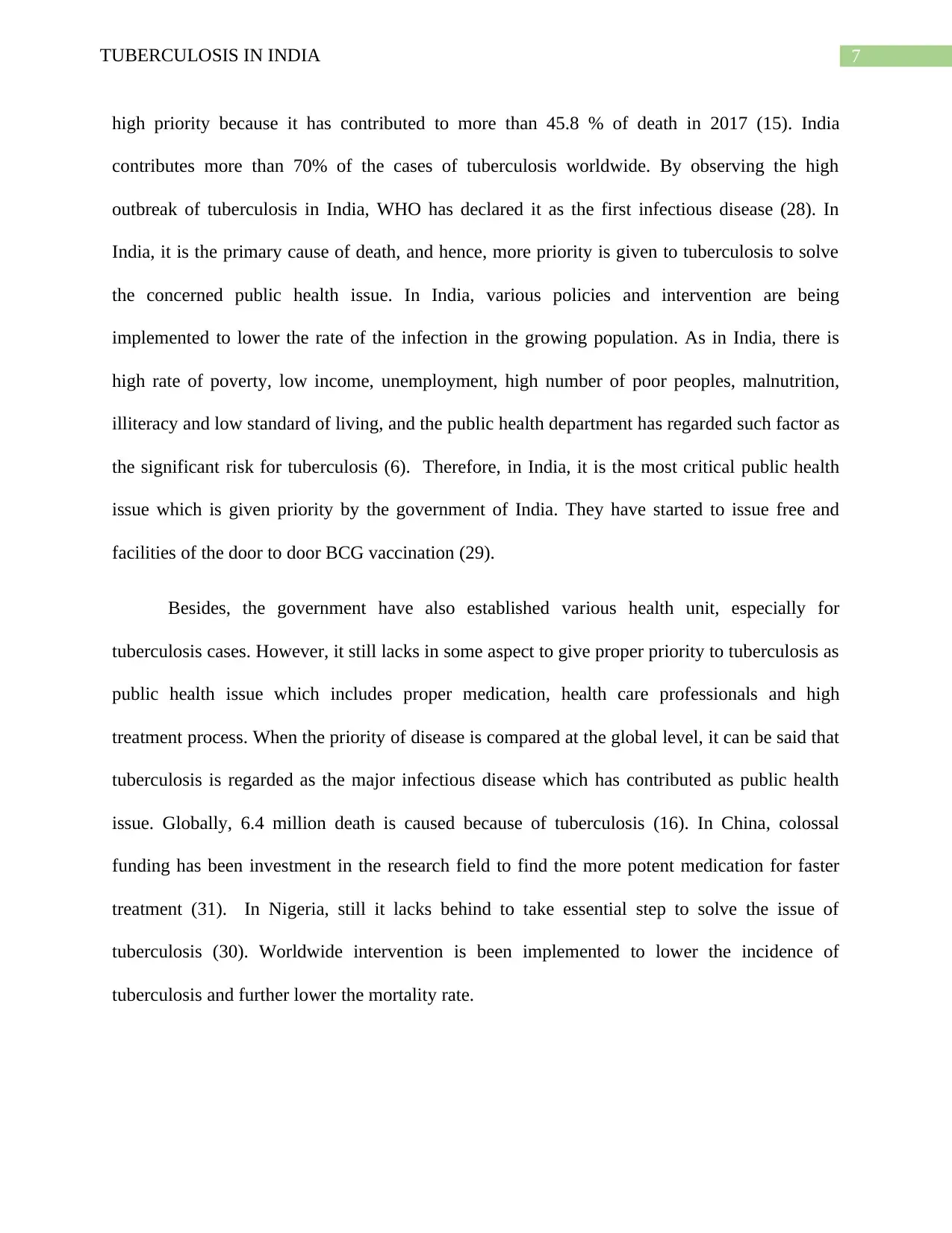
7TUBERCULOSIS IN INDIA
high priority because it has contributed to more than 45.8 % of death in 2017 (15). India
contributes more than 70% of the cases of tuberculosis worldwide. By observing the high
outbreak of tuberculosis in India, WHO has declared it as the first infectious disease (28). In
India, it is the primary cause of death, and hence, more priority is given to tuberculosis to solve
the concerned public health issue. In India, various policies and intervention are being
implemented to lower the rate of the infection in the growing population. As in India, there is
high rate of poverty, low income, unemployment, high number of poor peoples, malnutrition,
illiteracy and low standard of living, and the public health department has regarded such factor as
the significant risk for tuberculosis (6). Therefore, in India, it is the most critical public health
issue which is given priority by the government of India. They have started to issue free and
facilities of the door to door BCG vaccination (29).
Besides, the government have also established various health unit, especially for
tuberculosis cases. However, it still lacks in some aspect to give proper priority to tuberculosis as
public health issue which includes proper medication, health care professionals and high
treatment process. When the priority of disease is compared at the global level, it can be said that
tuberculosis is regarded as the major infectious disease which has contributed as public health
issue. Globally, 6.4 million death is caused because of tuberculosis (16). In China, colossal
funding has been investment in the research field to find the more potent medication for faster
treatment (31). In Nigeria, still it lacks behind to take essential step to solve the issue of
tuberculosis (30). Worldwide intervention is been implemented to lower the incidence of
tuberculosis and further lower the mortality rate.
high priority because it has contributed to more than 45.8 % of death in 2017 (15). India
contributes more than 70% of the cases of tuberculosis worldwide. By observing the high
outbreak of tuberculosis in India, WHO has declared it as the first infectious disease (28). In
India, it is the primary cause of death, and hence, more priority is given to tuberculosis to solve
the concerned public health issue. In India, various policies and intervention are being
implemented to lower the rate of the infection in the growing population. As in India, there is
high rate of poverty, low income, unemployment, high number of poor peoples, malnutrition,
illiteracy and low standard of living, and the public health department has regarded such factor as
the significant risk for tuberculosis (6). Therefore, in India, it is the most critical public health
issue which is given priority by the government of India. They have started to issue free and
facilities of the door to door BCG vaccination (29).
Besides, the government have also established various health unit, especially for
tuberculosis cases. However, it still lacks in some aspect to give proper priority to tuberculosis as
public health issue which includes proper medication, health care professionals and high
treatment process. When the priority of disease is compared at the global level, it can be said that
tuberculosis is regarded as the major infectious disease which has contributed as public health
issue. Globally, 6.4 million death is caused because of tuberculosis (16). In China, colossal
funding has been investment in the research field to find the more potent medication for faster
treatment (31). In Nigeria, still it lacks behind to take essential step to solve the issue of
tuberculosis (30). Worldwide intervention is been implemented to lower the incidence of
tuberculosis and further lower the mortality rate.
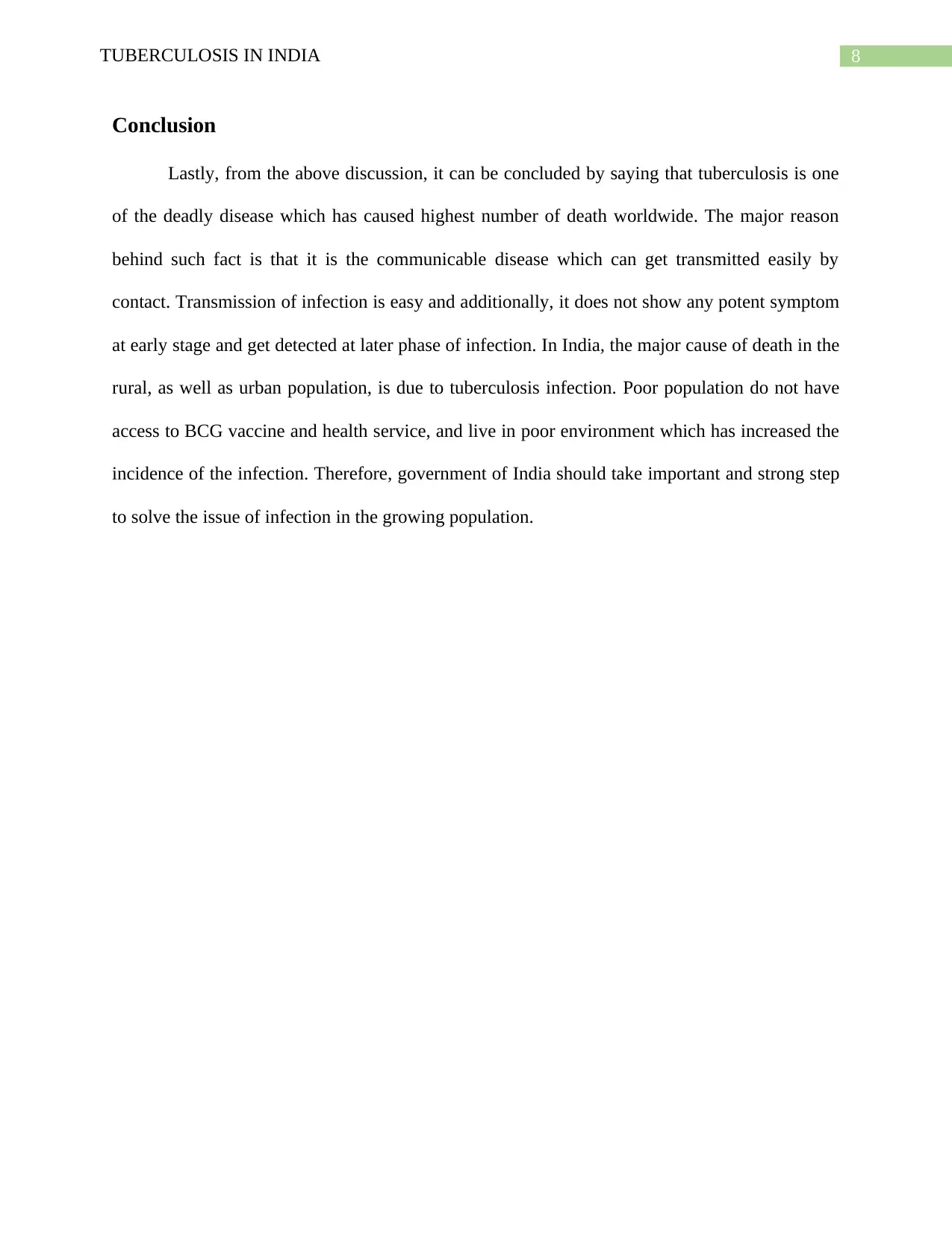
8TUBERCULOSIS IN INDIA
Conclusion
Lastly, from the above discussion, it can be concluded by saying that tuberculosis is one
of the deadly disease which has caused highest number of death worldwide. The major reason
behind such fact is that it is the communicable disease which can get transmitted easily by
contact. Transmission of infection is easy and additionally, it does not show any potent symptom
at early stage and get detected at later phase of infection. In India, the major cause of death in the
rural, as well as urban population, is due to tuberculosis infection. Poor population do not have
access to BCG vaccine and health service, and live in poor environment which has increased the
incidence of the infection. Therefore, government of India should take important and strong step
to solve the issue of infection in the growing population.
Conclusion
Lastly, from the above discussion, it can be concluded by saying that tuberculosis is one
of the deadly disease which has caused highest number of death worldwide. The major reason
behind such fact is that it is the communicable disease which can get transmitted easily by
contact. Transmission of infection is easy and additionally, it does not show any potent symptom
at early stage and get detected at later phase of infection. In India, the major cause of death in the
rural, as well as urban population, is due to tuberculosis infection. Poor population do not have
access to BCG vaccine and health service, and live in poor environment which has increased the
incidence of the infection. Therefore, government of India should take important and strong step
to solve the issue of infection in the growing population.

9TUBERCULOSIS IN INDIA
Reference
1. Glaziou P, Sismanidis C, Floyd K, Raviglione M. Global epidemiology of tuberculosis.
Cold Spring Harbor perspectives in medicine. 2015 Feb 1;5(2):a017798.
2. Dheda K, Gumbo T, Maartens G, Dooley KE, McNerney R, Murray M, Furin J, Nardell
EA, London L, Lessem E, Theron G. The epidemiology, pathogenesis, transmission,
diagnosis, and management of multidrug-resistant, extensively drug-resistant, and
incurable tuberculosis. The lancet Respiratory medicine. 2017 Apr 1;5(4):291-360.
3. Tacconelli E, Carrara E, Savoldi A, Harbarth S, Mendelson M, Monnet DL, Pulcini C,
Kahlmeter G, Kluytmans J, Carmeli Y, Ouellette M. Discovery, research, and
development of new antibiotics: the WHO priority list of antibiotic-resistant bacteria and
tuberculosis. The Lancet Infectious Diseases. 2018 Mar 1;18(3):318-27.
4. Sharma SK, Ryan H, Khaparde S, Sachdeva KS, Singh AD, Mohan A, Sarin R,
Paramasivan CN, Kumar P, Nischal N, Khatiwada S. Index-TB Guidelines: Guidelines
on extrapulmonary tuberculosis for India. The Indian journal of medical research. 2017
Apr;145(4):448.
5. Sharma A, Hill A, Kurbatova E, van der Walt M, Kvasnovsky C, Tupasi TE, Caoili JC,
Gler MT, Volchenkov GV, Kazennyy BY, Demikhova OV. Estimating the future burden
of multidrug-resistant and extensively drug-resistant tuberculosis in India, the
Philippines, Russia, and South Africa: a mathematical modelling study. The Lancet
Infectious Diseases. 2017 Jul 1;17(7):707-15.
6. Arinaminpathy N, Batra D, Khaparde S, Vualnam T, Maheshwari N, Sharma L, Nair SA,
Dewan P. The number of privately treated tuberculosis cases in India: an estimation from
drug sales data. The Lancet Infectious Diseases. 2016 Nov 1;16(11):1255-60.
Reference
1. Glaziou P, Sismanidis C, Floyd K, Raviglione M. Global epidemiology of tuberculosis.
Cold Spring Harbor perspectives in medicine. 2015 Feb 1;5(2):a017798.
2. Dheda K, Gumbo T, Maartens G, Dooley KE, McNerney R, Murray M, Furin J, Nardell
EA, London L, Lessem E, Theron G. The epidemiology, pathogenesis, transmission,
diagnosis, and management of multidrug-resistant, extensively drug-resistant, and
incurable tuberculosis. The lancet Respiratory medicine. 2017 Apr 1;5(4):291-360.
3. Tacconelli E, Carrara E, Savoldi A, Harbarth S, Mendelson M, Monnet DL, Pulcini C,
Kahlmeter G, Kluytmans J, Carmeli Y, Ouellette M. Discovery, research, and
development of new antibiotics: the WHO priority list of antibiotic-resistant bacteria and
tuberculosis. The Lancet Infectious Diseases. 2018 Mar 1;18(3):318-27.
4. Sharma SK, Ryan H, Khaparde S, Sachdeva KS, Singh AD, Mohan A, Sarin R,
Paramasivan CN, Kumar P, Nischal N, Khatiwada S. Index-TB Guidelines: Guidelines
on extrapulmonary tuberculosis for India. The Indian journal of medical research. 2017
Apr;145(4):448.
5. Sharma A, Hill A, Kurbatova E, van der Walt M, Kvasnovsky C, Tupasi TE, Caoili JC,
Gler MT, Volchenkov GV, Kazennyy BY, Demikhova OV. Estimating the future burden
of multidrug-resistant and extensively drug-resistant tuberculosis in India, the
Philippines, Russia, and South Africa: a mathematical modelling study. The Lancet
Infectious Diseases. 2017 Jul 1;17(7):707-15.
6. Arinaminpathy N, Batra D, Khaparde S, Vualnam T, Maheshwari N, Sharma L, Nair SA,
Dewan P. The number of privately treated tuberculosis cases in India: an estimation from
drug sales data. The Lancet Infectious Diseases. 2016 Nov 1;16(11):1255-60.
Secure Best Marks with AI Grader
Need help grading? Try our AI Grader for instant feedback on your assignments.
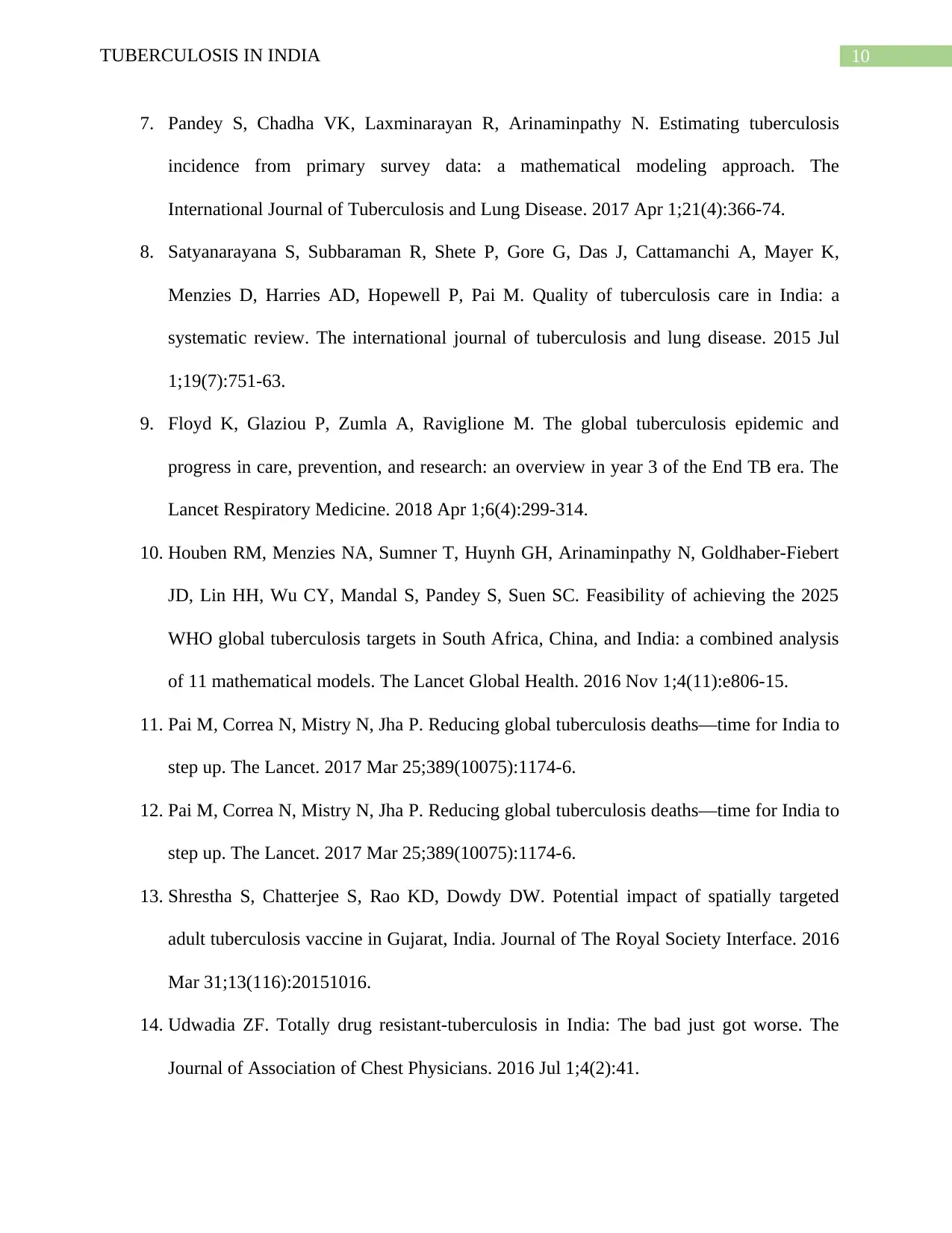
10TUBERCULOSIS IN INDIA
7. Pandey S, Chadha VK, Laxminarayan R, Arinaminpathy N. Estimating tuberculosis
incidence from primary survey data: a mathematical modeling approach. The
International Journal of Tuberculosis and Lung Disease. 2017 Apr 1;21(4):366-74.
8. Satyanarayana S, Subbaraman R, Shete P, Gore G, Das J, Cattamanchi A, Mayer K,
Menzies D, Harries AD, Hopewell P, Pai M. Quality of tuberculosis care in India: a
systematic review. The international journal of tuberculosis and lung disease. 2015 Jul
1;19(7):751-63.
9. Floyd K, Glaziou P, Zumla A, Raviglione M. The global tuberculosis epidemic and
progress in care, prevention, and research: an overview in year 3 of the End TB era. The
Lancet Respiratory Medicine. 2018 Apr 1;6(4):299-314.
10. Houben RM, Menzies NA, Sumner T, Huynh GH, Arinaminpathy N, Goldhaber-Fiebert
JD, Lin HH, Wu CY, Mandal S, Pandey S, Suen SC. Feasibility of achieving the 2025
WHO global tuberculosis targets in South Africa, China, and India: a combined analysis
of 11 mathematical models. The Lancet Global Health. 2016 Nov 1;4(11):e806-15.
11. Pai M, Correa N, Mistry N, Jha P. Reducing global tuberculosis deaths—time for India to
step up. The Lancet. 2017 Mar 25;389(10075):1174-6.
12. Pai M, Correa N, Mistry N, Jha P. Reducing global tuberculosis deaths—time for India to
step up. The Lancet. 2017 Mar 25;389(10075):1174-6.
13. Shrestha S, Chatterjee S, Rao KD, Dowdy DW. Potential impact of spatially targeted
adult tuberculosis vaccine in Gujarat, India. Journal of The Royal Society Interface. 2016
Mar 31;13(116):20151016.
14. Udwadia ZF. Totally drug resistant-tuberculosis in India: The bad just got worse. The
Journal of Association of Chest Physicians. 2016 Jul 1;4(2):41.
7. Pandey S, Chadha VK, Laxminarayan R, Arinaminpathy N. Estimating tuberculosis
incidence from primary survey data: a mathematical modeling approach. The
International Journal of Tuberculosis and Lung Disease. 2017 Apr 1;21(4):366-74.
8. Satyanarayana S, Subbaraman R, Shete P, Gore G, Das J, Cattamanchi A, Mayer K,
Menzies D, Harries AD, Hopewell P, Pai M. Quality of tuberculosis care in India: a
systematic review. The international journal of tuberculosis and lung disease. 2015 Jul
1;19(7):751-63.
9. Floyd K, Glaziou P, Zumla A, Raviglione M. The global tuberculosis epidemic and
progress in care, prevention, and research: an overview in year 3 of the End TB era. The
Lancet Respiratory Medicine. 2018 Apr 1;6(4):299-314.
10. Houben RM, Menzies NA, Sumner T, Huynh GH, Arinaminpathy N, Goldhaber-Fiebert
JD, Lin HH, Wu CY, Mandal S, Pandey S, Suen SC. Feasibility of achieving the 2025
WHO global tuberculosis targets in South Africa, China, and India: a combined analysis
of 11 mathematical models. The Lancet Global Health. 2016 Nov 1;4(11):e806-15.
11. Pai M, Correa N, Mistry N, Jha P. Reducing global tuberculosis deaths—time for India to
step up. The Lancet. 2017 Mar 25;389(10075):1174-6.
12. Pai M, Correa N, Mistry N, Jha P. Reducing global tuberculosis deaths—time for India to
step up. The Lancet. 2017 Mar 25;389(10075):1174-6.
13. Shrestha S, Chatterjee S, Rao KD, Dowdy DW. Potential impact of spatially targeted
adult tuberculosis vaccine in Gujarat, India. Journal of The Royal Society Interface. 2016
Mar 31;13(116):20151016.
14. Udwadia ZF. Totally drug resistant-tuberculosis in India: The bad just got worse. The
Journal of Association of Chest Physicians. 2016 Jul 1;4(2):41.
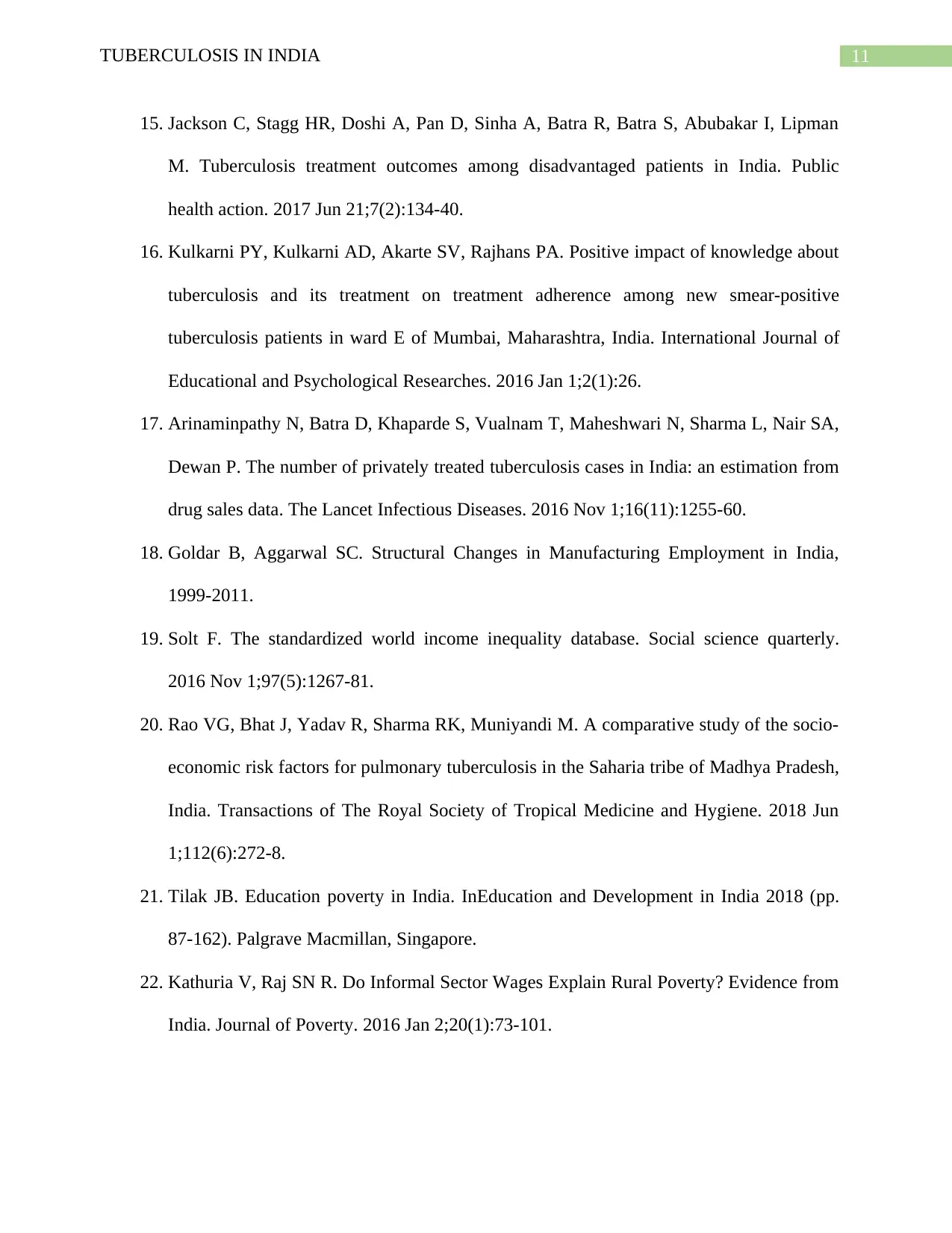
11TUBERCULOSIS IN INDIA
15. Jackson C, Stagg HR, Doshi A, Pan D, Sinha A, Batra R, Batra S, Abubakar I, Lipman
M. Tuberculosis treatment outcomes among disadvantaged patients in India. Public
health action. 2017 Jun 21;7(2):134-40.
16. Kulkarni PY, Kulkarni AD, Akarte SV, Rajhans PA. Positive impact of knowledge about
tuberculosis and its treatment on treatment adherence among new smear-positive
tuberculosis patients in ward E of Mumbai, Maharashtra, India. International Journal of
Educational and Psychological Researches. 2016 Jan 1;2(1):26.
17. Arinaminpathy N, Batra D, Khaparde S, Vualnam T, Maheshwari N, Sharma L, Nair SA,
Dewan P. The number of privately treated tuberculosis cases in India: an estimation from
drug sales data. The Lancet Infectious Diseases. 2016 Nov 1;16(11):1255-60.
18. Goldar B, Aggarwal SC. Structural Changes in Manufacturing Employment in India,
1999-2011.
19. Solt F. The standardized world income inequality database. Social science quarterly.
2016 Nov 1;97(5):1267-81.
20. Rao VG, Bhat J, Yadav R, Sharma RK, Muniyandi M. A comparative study of the socio-
economic risk factors for pulmonary tuberculosis in the Saharia tribe of Madhya Pradesh,
India. Transactions of The Royal Society of Tropical Medicine and Hygiene. 2018 Jun
1;112(6):272-8.
21. Tilak JB. Education poverty in India. InEducation and Development in India 2018 (pp.
87-162). Palgrave Macmillan, Singapore.
22. Kathuria V, Raj SN R. Do Informal Sector Wages Explain Rural Poverty? Evidence from
India. Journal of Poverty. 2016 Jan 2;20(1):73-101.
15. Jackson C, Stagg HR, Doshi A, Pan D, Sinha A, Batra R, Batra S, Abubakar I, Lipman
M. Tuberculosis treatment outcomes among disadvantaged patients in India. Public
health action. 2017 Jun 21;7(2):134-40.
16. Kulkarni PY, Kulkarni AD, Akarte SV, Rajhans PA. Positive impact of knowledge about
tuberculosis and its treatment on treatment adherence among new smear-positive
tuberculosis patients in ward E of Mumbai, Maharashtra, India. International Journal of
Educational and Psychological Researches. 2016 Jan 1;2(1):26.
17. Arinaminpathy N, Batra D, Khaparde S, Vualnam T, Maheshwari N, Sharma L, Nair SA,
Dewan P. The number of privately treated tuberculosis cases in India: an estimation from
drug sales data. The Lancet Infectious Diseases. 2016 Nov 1;16(11):1255-60.
18. Goldar B, Aggarwal SC. Structural Changes in Manufacturing Employment in India,
1999-2011.
19. Solt F. The standardized world income inequality database. Social science quarterly.
2016 Nov 1;97(5):1267-81.
20. Rao VG, Bhat J, Yadav R, Sharma RK, Muniyandi M. A comparative study of the socio-
economic risk factors for pulmonary tuberculosis in the Saharia tribe of Madhya Pradesh,
India. Transactions of The Royal Society of Tropical Medicine and Hygiene. 2018 Jun
1;112(6):272-8.
21. Tilak JB. Education poverty in India. InEducation and Development in India 2018 (pp.
87-162). Palgrave Macmillan, Singapore.
22. Kathuria V, Raj SN R. Do Informal Sector Wages Explain Rural Poverty? Evidence from
India. Journal of Poverty. 2016 Jan 2;20(1):73-101.
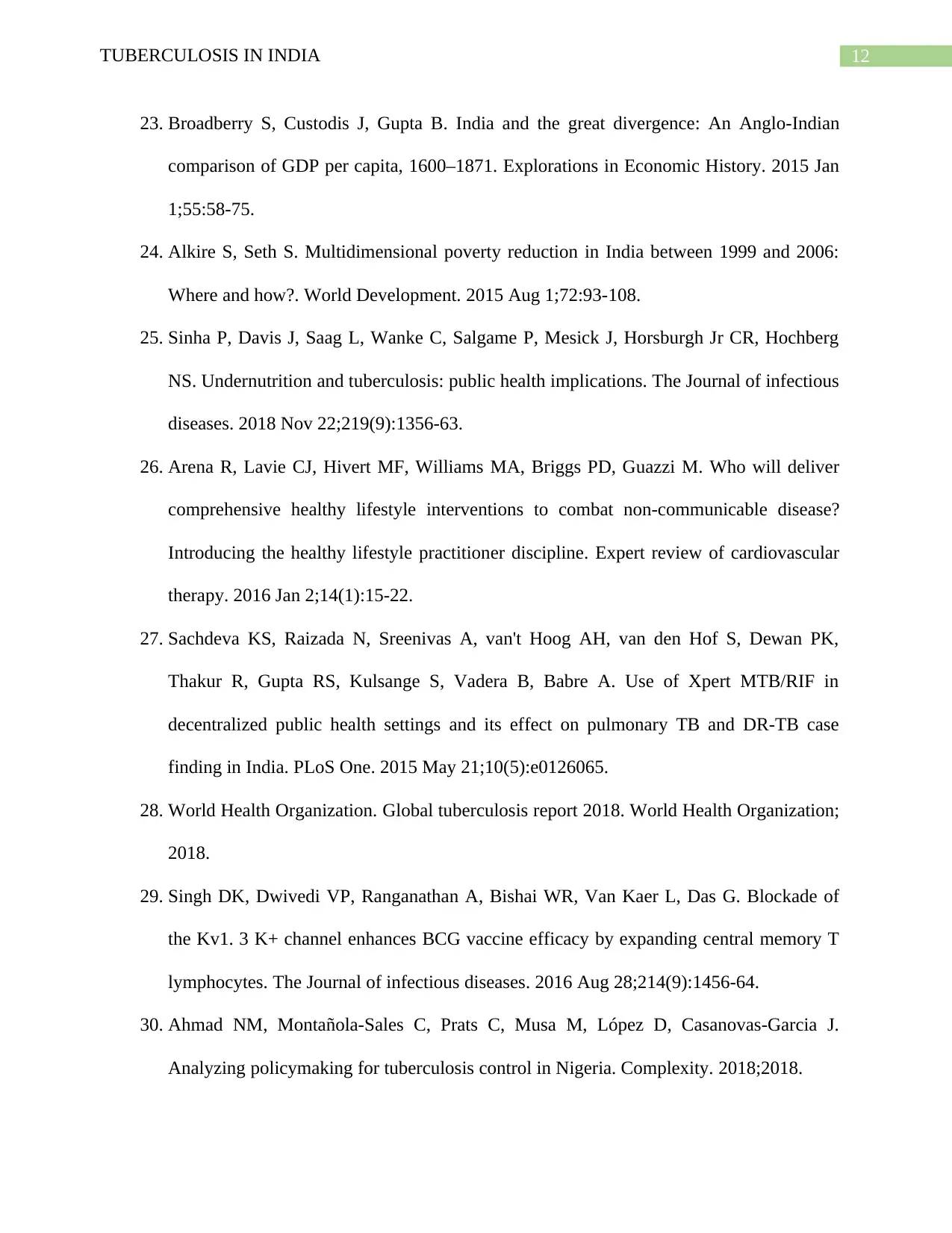
12TUBERCULOSIS IN INDIA
23. Broadberry S, Custodis J, Gupta B. India and the great divergence: An Anglo-Indian
comparison of GDP per capita, 1600–1871. Explorations in Economic History. 2015 Jan
1;55:58-75.
24. Alkire S, Seth S. Multidimensional poverty reduction in India between 1999 and 2006:
Where and how?. World Development. 2015 Aug 1;72:93-108.
25. Sinha P, Davis J, Saag L, Wanke C, Salgame P, Mesick J, Horsburgh Jr CR, Hochberg
NS. Undernutrition and tuberculosis: public health implications. The Journal of infectious
diseases. 2018 Nov 22;219(9):1356-63.
26. Arena R, Lavie CJ, Hivert MF, Williams MA, Briggs PD, Guazzi M. Who will deliver
comprehensive healthy lifestyle interventions to combat non-communicable disease?
Introducing the healthy lifestyle practitioner discipline. Expert review of cardiovascular
therapy. 2016 Jan 2;14(1):15-22.
27. Sachdeva KS, Raizada N, Sreenivas A, van't Hoog AH, van den Hof S, Dewan PK,
Thakur R, Gupta RS, Kulsange S, Vadera B, Babre A. Use of Xpert MTB/RIF in
decentralized public health settings and its effect on pulmonary TB and DR-TB case
finding in India. PLoS One. 2015 May 21;10(5):e0126065.
28. World Health Organization. Global tuberculosis report 2018. World Health Organization;
2018.
29. Singh DK, Dwivedi VP, Ranganathan A, Bishai WR, Van Kaer L, Das G. Blockade of
the Kv1. 3 K+ channel enhances BCG vaccine efficacy by expanding central memory T
lymphocytes. The Journal of infectious diseases. 2016 Aug 28;214(9):1456-64.
30. Ahmad NM, Montañola-Sales C, Prats C, Musa M, López D, Casanovas-Garcia J.
Analyzing policymaking for tuberculosis control in Nigeria. Complexity. 2018;2018.
23. Broadberry S, Custodis J, Gupta B. India and the great divergence: An Anglo-Indian
comparison of GDP per capita, 1600–1871. Explorations in Economic History. 2015 Jan
1;55:58-75.
24. Alkire S, Seth S. Multidimensional poverty reduction in India between 1999 and 2006:
Where and how?. World Development. 2015 Aug 1;72:93-108.
25. Sinha P, Davis J, Saag L, Wanke C, Salgame P, Mesick J, Horsburgh Jr CR, Hochberg
NS. Undernutrition and tuberculosis: public health implications. The Journal of infectious
diseases. 2018 Nov 22;219(9):1356-63.
26. Arena R, Lavie CJ, Hivert MF, Williams MA, Briggs PD, Guazzi M. Who will deliver
comprehensive healthy lifestyle interventions to combat non-communicable disease?
Introducing the healthy lifestyle practitioner discipline. Expert review of cardiovascular
therapy. 2016 Jan 2;14(1):15-22.
27. Sachdeva KS, Raizada N, Sreenivas A, van't Hoog AH, van den Hof S, Dewan PK,
Thakur R, Gupta RS, Kulsange S, Vadera B, Babre A. Use of Xpert MTB/RIF in
decentralized public health settings and its effect on pulmonary TB and DR-TB case
finding in India. PLoS One. 2015 May 21;10(5):e0126065.
28. World Health Organization. Global tuberculosis report 2018. World Health Organization;
2018.
29. Singh DK, Dwivedi VP, Ranganathan A, Bishai WR, Van Kaer L, Das G. Blockade of
the Kv1. 3 K+ channel enhances BCG vaccine efficacy by expanding central memory T
lymphocytes. The Journal of infectious diseases. 2016 Aug 28;214(9):1456-64.
30. Ahmad NM, Montañola-Sales C, Prats C, Musa M, López D, Casanovas-Garcia J.
Analyzing policymaking for tuberculosis control in Nigeria. Complexity. 2018;2018.
Paraphrase This Document
Need a fresh take? Get an instant paraphrase of this document with our AI Paraphraser
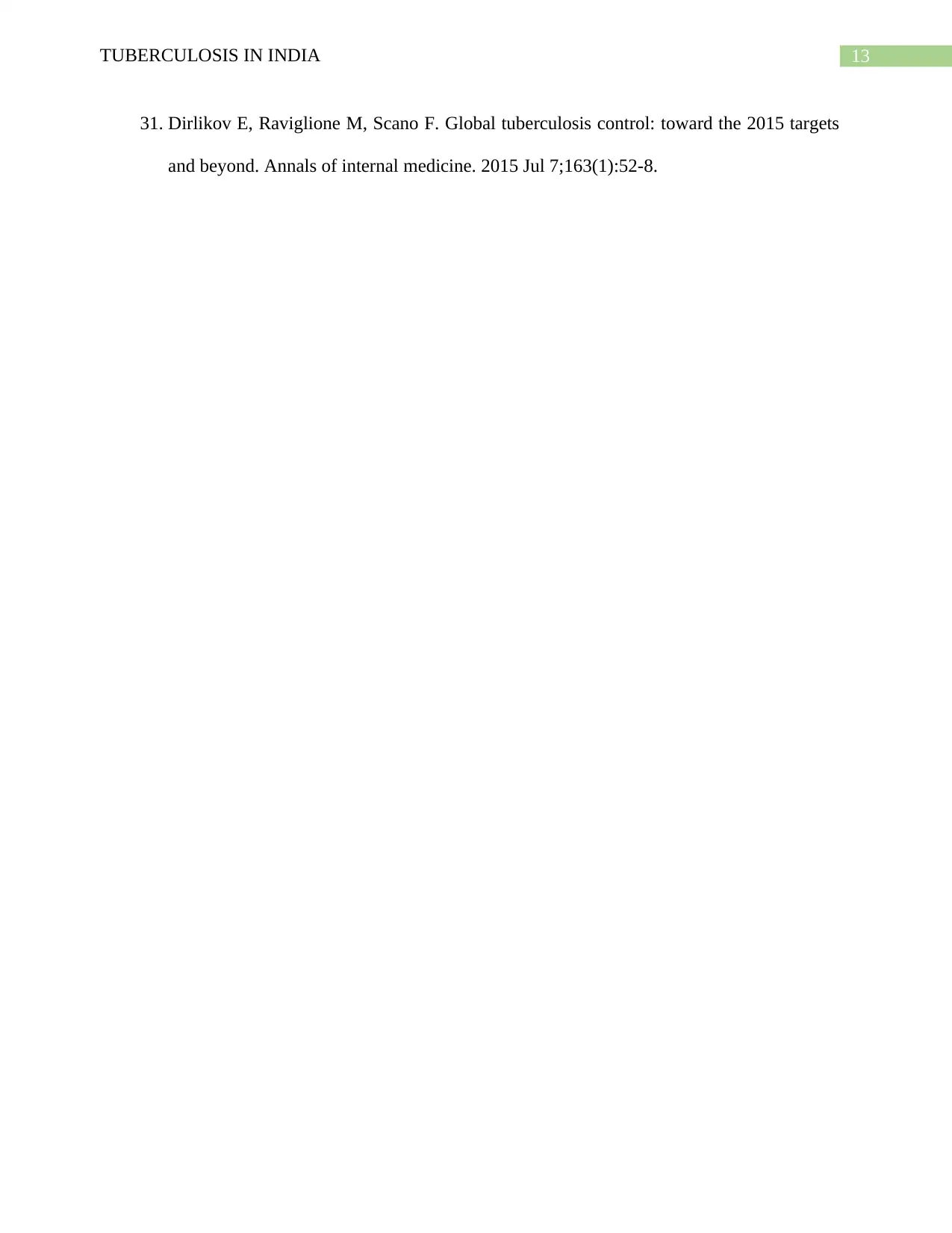
13TUBERCULOSIS IN INDIA
31. Dirlikov E, Raviglione M, Scano F. Global tuberculosis control: toward the 2015 targets
and beyond. Annals of internal medicine. 2015 Jul 7;163(1):52-8.
31. Dirlikov E, Raviglione M, Scano F. Global tuberculosis control: toward the 2015 targets
and beyond. Annals of internal medicine. 2015 Jul 7;163(1):52-8.
1 out of 14
Related Documents
Your All-in-One AI-Powered Toolkit for Academic Success.
+13062052269
info@desklib.com
Available 24*7 on WhatsApp / Email
![[object Object]](/_next/static/media/star-bottom.7253800d.svg)
Unlock your academic potential
© 2024 | Zucol Services PVT LTD | All rights reserved.





